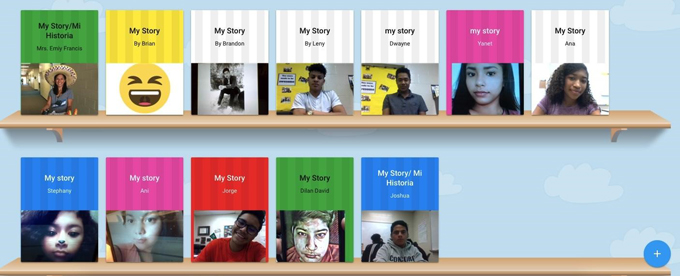 “One of our most important responsibilities in school is to protect and advocate for our students’ individuality and identity; it’s their greatest gift.” —Hamish Brewer
“One of our most important responsibilities in school is to protect and advocate for our students’ individuality and identity; it’s their greatest gift.” —Hamish Brewer
Personal experiences are powerful. My journey as a first-generation immigrant and a former English learner is now central to what I do. My personal experiences, coupled with my responsibilities as an educator, have helped me to embrace the role of an advocate and to create and establish a sense of culture that values students’ greatest gifts: identity and individuality.
When ILA launched its Children’s Rights to Read campaign last fall, I immediately saw connections to my teaching philosophy and the role I can play in advocating for those rights.
Children’s Rights to Read—10 fundamental rights ILA asserts every child deserves—is a campaign in which ILA aims to activate educators around the world to ensure every child, everywhere, receives access to the education, opportunities, and resources needed to read.
As a high school teacher of English as a second language (ESL), my job is to analyze my students’ needs and to develop their linguistic and communicative competence in English in all language domains.
However, my goal as an educator is to create meaningful learning experiences that serve as pathways for connection. I can create those experiences through the framework of Children’s Rights to Read.
Enacting the rights
Right No. 4, borrowing language from scholar Rudine Sims Bishop, is the right of students to read texts that mirror their experiences and languages, provide windows into the lives of others, and open doors into our diverse world.
I do this by providing texts that validate and celebrate my students’ unique backgrounds. We make time to share our own personal stories and experiences to bring awareness to our cultural diversities. We create projects that take us beyond learning the rules of the English language. We don’t just extract information to learn from it; we transact with the text by taking what we read and finding ways to apply it to our lives or to change the world around us.
I find it imperative to establish a classroom culture where my students feel a sense of belonging and acceptance—where they celebrate both their similarities and differences.
Having a clear understanding of my students’ rights to read—specifically the “right to read text that mirrors their experiences and language” and “the right to read as a springboard for other forms of communication”—I use picture books and storytelling as tools to facilitate language acquisition and comprehension.
Picture book connections
When it comes to selecting picture books for my lessons, I intentionally select books that
- Provide rich text and illustrations to build literacy competencies
- Facilitate language acquisition
- Validate my students’ experiences and perspectives
Some examples of books I’ve used are:
- I’m New Here and Someone New by Anne Sibley O’Brien (Charlesbridge)
- My Shoes and I by René Colato Laínez (Boyds Mills)
- Turning Pages: My Life Story by Sonia Sotomayor (Philomel)
- Four Feet, Two Sandals by Karen Lynn Williams and Khadra Mohammed (Eerdmans)
- Brothers in Hope by Mary Williams (Lee & Low)
- Last Stop on Market Street by Matt de la Peña (G.P. Putnam’s Sons)
Picture books are powerful tools for English learners, even at the high school level, to acquire and develop their English skills because the illustrations provide the support they need for meaning making. Picture books also serve as pathways to understanding our own experiences. My immigrant journey, as well as my students’ immigrant journeys, may be viewed by ourselves and others as something unworthy to share, read, or learn about.
However, diverse picture books with characters that highlight and celebrate journeys like ours can provide the sense of validation we need to embrace our experiences. Through the connections we make with the characters who not only share our experiences but also exemplify courage and belonging, we are empowered to create—and be the heroes in—our own stories.
Affirming existence through storytelling
Affirming students’ individuality and identity requires action. First, we must learn about our students. We can do this by providing opportunities for them to research and share information about their personal histories. This allows us to build upon students’ knowledge, culture, language, identity, and experiences to create a more culturally responsive curriculum.
In our class, reading diverse books that reflect students’ culture, language, and experiences empowers them to not just understand their experiences but to tell their own stories. Through this storytelling, we exercise Right No. 9: the right to read as a springboard for other forms of communication, such as writing, speaking, and visually representing.
Using the app WriteReader, my students and I share our immigrant stories. This platform serves as a long-anticipated opportunity to showcase our experiences, our culture, and our language. Their stories cultivate a culture of value, respect, and acceptance for our identity and individuality and encourage our students to share and consume stories that matter.
Following are some of our stories:
So, embrace the right our students have to read and to be inspired by diverse characters and experiences. Empower your students with continuous opportunities to share their story—opportunities that reaffirm their existence, identity, and individuality.
Astrid Emily Francis is an ESL teacher at Concord High School in Concord, NC. She serves students in 9th–12th grade with various English proficiency levels. Francis earned a BA in Spanish, and a MAT in ESL from UNC Charlotte.